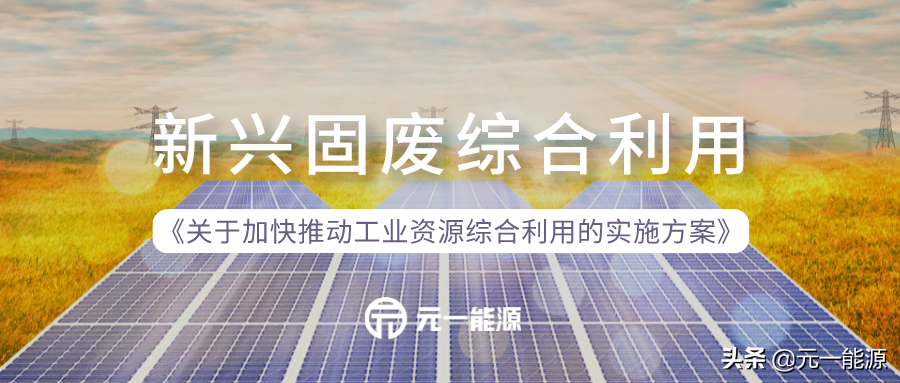On February 10, the Ministry of Industry and Information Technology and other eight departments jointly issued the "Implementation Plan for Accelerating the Comprehensive Utilization of Industrial Resources", which mentioned exploring the path of comprehensive utilization of emerging solid waste, promoting the research and development and industrialization of emerging solid waste comprehensive utilization technologies such as waste photovoltaic modules and wind power blades, increasing the research and development and promotion of comprehensive utilization of complete sets of technical equipment, and exploring the technical route of comprehensive utilization of emerging solid waste.

Emerging solid waste treatment issues such as waste photovoltaic modules have attracted more and more attention from policies. The "Opinions of the CPC Central Committee and the State Council on Deepening the Battle against Pollution" makes it clear that by 2025, the ability to control solid waste and new pollutants will be significantly enhanced. The "Notice on Carrying out demonstrations of comprehensive utilization of bulk solid waste" proposes that by 2025, 50 demonstration bases for the comprehensive utilization of bulk solid waste will be built, and the comprehensive utilization rate of bulk solid waste in the demonstration base will reach more than 75%, which will significantly enhance the support capacity for regional carbon reduction.
In recent years, the mainland's new energy industry has flourished, and the amount of emerging solid waste generated has also shown explosive growth. According to the "China Carbon Neutrality Research Report before 2060", the installed capacity of photovoltaic and wind power on the mainland will reach 1.5 billion kilowatts and 1.1 billion kilowatts respectively in 2035, and the number of new energy vehicles will reach 160 million. At the same time, the installed capacity of photovoltaic and wind power decommissioned each year will reach 110 million kilowatts / year and 0.7 billion kilowatts / year, and the decommissioned new energy vehicle batteries will reach 2.7 million / year, corresponding to the generation of scrapped photovoltaic modules, waste wind turbine blades and power batteries of about 1.05 million tons, 1 million tons and 3 million tons, respectively.
Emerging solid waste contains a variety of rare precious metal resources, such as silver, tellurium, indium, gallium, etc., if not properly treated, will seriously pollute water, gas, soil and other environmental media, showing a dual endowment of both resources and environmental hazards.
It can be seen that the treatment and disposal of solid waste in the mainland must strictly follow the concept of low-carbon ecology, strengthen the whole process control technology route of "source reduction, process resource and terminal harmlessness", and give full play to the synergistic effect of comprehensive utilization of solid waste on the realization of pollution and carbon reduction goals.
For waste crystalline silicon photovoltaic modules, there are currently four ways to deal with them in the mainland, namely reuse, landfill, recycling and incineration, of which recycling is regarded as the best way. Among the waste photovoltaic modules, glass accounts for about 70% of the total weight, aluminum materials account for about 18%, and semiconductor materials account for about 4%. In other words, most of the materials of photovoltaic modules have the possibility of recycling. Through the recycling and reuse of waste photovoltaic modules, the recycling of rare metals, glass, aluminum and semiconductors can be realized to reduce the exploitation of primary resources, reduce the energy consumption of resource extraction, and reduce the impact and damage to the ecological environment.
The mainland started late in the field of heavy metal resource recovery of waste photovoltaic modules, and has not yet formed an industrial scale. In the face of the problems of disposal and resource utilization of decommissioned and scrapped photovoltaic modules, developed countries have made useful explorations in strengthening the research and development of resource technology, supporting the formulation of promotion policies, and strengthening the promotion of applications, and can learn some experience from them:
The first is to continuously develop waste photovoltaic module recycling and treatment technology. From the perspective of economic cost, efforts should be made to develop new technologies and equipment with high recovery rate and low energy consumption. From the perspective of environmental protection, it is also necessary to take into account the reduction of pollutants in the recycling process, reduce the carbon emissions in the process of raw material mining, processing and purification, and obtain high-value products.
The second is to gradually build a sound photovoltaic waste recycling policy system and platform. In terms of policy, the recycling of waste photovoltaic modules can be included in the recycling management policy of waste electrical and electronic products. In terms of platform, in view of the characteristics of photovoltaic power generation in the mainland, which is mostly built in remote areas and the information circulation of the supply and demand market is not smooth, enterprises can be encouraged to use modern information technologies and means such as the Internet, big data and cloud computing to establish a component recycling information service platform to provide support for upstream recycling enterprises and downstream dismantling and utilization of enterprise information release, bidding procurement and logistics services.
The third is to promote the technological progress and industrial application of waste photovoltaic module recycling. From the perspective of the whole life cycle of the industry, deploy and promote the industrial application demonstration of waste photovoltaic module recycling technology, provide guarantee for photovoltaic power generation technology from the perspective of solid waste reduction and resource utilization, and more conducive to the promotion of the mainland's conversion from traditional energy to new clean energy, and help achieve carbon peaking and carbon neutrality.
Under the constraints of cost and technology, there is still a long way to go for the clean treatment of emerging solid waste of photovoltaic wind power. In order to completely solve such problems, the industry should cooperate with multiple fields such as materials and construction, and multi-industry integration and collaboration will help transform to a circular economy, thereby achieving sustainable development of various industries.